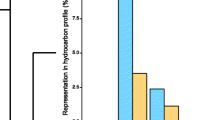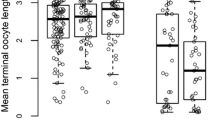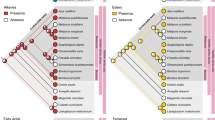Abstract
Social insects are known for their reproductive division of labor between queens and workers, whereby queens lay the majority of the colony’s eggs, and workers engage mostly in non-reproductive tasks. Queens produce pheromones that signal their presence and fertility to workers, which in turn generally remain sterile. Recently, it has been discovered that specific queen-characteristic cuticular hydrocarbons (CHCs) function as queen pheromones across multiple lineages of social insects. In the common wasp, Vespula vulgaris, several long-chain linear alkanes and 3-methylalkanes were shown to act as queen signals. Here, we describe similar bioassays with a related species of highly eusocial vespine wasp, the Saxon wasp, Dolichovespula saxonica. We show that a blend of queen-characteristic hydrocarbons that are structurally related to those of the common wasp inhibit worker reproduction, suggesting conservation of queen pheromones across social wasps. Overall, our results highlight the central importance of CHCs in chemical communication among social insects in general, and as conserved queen pheromones in these social wasps in particular.


Similar content being viewed by others
References
Aitchison J (1986) The statistical analysis of compositional data, vol 44. vol 2. Blackburn Press, Caldwell
Amsalem E, Orlova M, Grozinger CM (2015) A conserved class of queen pheromones? Re-evaluating the evidence in bumblebees (Bombus impatiens). Proc R Soc Lond B Biol Sci 282:20151800
Blomquist GJ, Bagnères AG (2010) Insect hydrocarbons: biology, biochemistry and chemical ecology. Cambridge University Press, Cambridge, UK
Bonckaert W, van Zweden JS, d’Ettorre P, Billen J, Wenseleers T (2011) Colony stage and not facultative policing explains pattern of worker reproduction in the Saxon wasp. Mol Ecol 20:3455–3468
Brunner E, Kroiss J, Trindl A, Heinze J (2011) Queen pheromones in Temnothorax ants: control or honest signal? BMC Evol Biol 11:55
Carlson DA, Roan CS, Yost RA, Hector J (1989) Dimethyl disulfide derivatives of long chain alkenes, alkadienes, and alkatrienes for gas chromatography/mass spectrometry. Anal Chem 61:1564–1571
Châline N, Sandoz JC, Martin SJ, Ratnieks FLW, Jones GR (2005) Learning and discrimination of individual cuticular hydrocarbons by honeybees (Apis mellifera). Chem Senses 30:327–335
de Narbonne MM, van Zweden JS, Bello JE, Wenseleers T, Millar JG, d’Ettorre P (2016) Biological activity of the enantiomers of 3-methylhentriacontane, a queen pheromone of the ant Lasius niger. J Exp Biol 219:1632–1638
di Mauro G, Perez M, Lorenzi MC, Guerrieri FJ, Millar JG, d’Ettorre P (2015) Ants discriminate between different hydrocarbon concentrations. Front Ecol Evol 3:133
Foster K, Ratnieks F (2000) Social insects - facultative worker policing in a wasp. Nature 407:692–693
Heinze J, d’Ettorre P (2009) Honest and dishonest communication in social Hymenoptera. J Exp Biol 212:1775–1779
Holman L (2012) Costs and constraints conspire to produce honest signalling: insights from an ant queen pheromone. Evolution 66:2094–2105
Holman L (2014) Bumblebee size polymorphism and worker response to queen pheromone. Peer J 2:e604
Holman L, Jørgensen CG, Nielsen J, d’Ettorre P (2010) Identification of an ant queen pheromone regulating worker sterility. Proc R Soc Lond B Biol Sci 277:3793–3800
Holman L, Lanfear R, d’Ettorre P (2013) The evolution of queen pheromones in the ant genus Lasius. J Evol Biol 26:1549–1558
Holman L, Hanley B, Millar JG (2016a) Highly specific responses to queen pheromone in three Lasius ant species. Behav Ecol Sociobiol 70:387–392
Holman L, van Zweden JS, Oliveira RC, Van Oystaeyen A, Wenseleers T (2016b) Conserved queen pheromones in bumblebees: A reply to Amsalem et al. PeerJ 4:e2003v2001 doi:10.7287/peerj.preprints.2003v2001
Howard RW, Blomquist GJ (2005) Ecological, behavioral, and biochemical aspects of insect hydrocarbons. Annu Rev Entomol 50:371–393
Keller L, Nonacs P (1993) The role of queen pheromones in social insects: queen control or queen signal? Anim Behav 45:787–794
Kocher SD, Grozinger CM (2011) Cooperation, conflict, and the evolution of queen pheromones. J Chem Ecol 37:1263–1275
Le Conte Y, Hefetz A (2008) Primer pheromones in social Hymenoptera. Annu Rev Entomol 53:523–542
Lê S, Josse J, Husson F (2008) FactoMineR: an R package for multivariate analysis. J Stat Softw 25:1–18
Liebig J (2010) Hydrocarbon profiles indicate fertility and dominance status in ant, bee, and wasp colonies. In: Insect hydrocarbons: biology, biochemistry, and chemical ecology. Cambridge University Press, pp 282–324
Monnin T (2006) Chemical recognition of reproductive status in social insects. Ann Zool Fenn 43:515–530
Oi CA, van Zweden JS, Oliveira RC, Van Oystaeyen A, Nascimento FS, Wenseleers T (2015a) The origin and evolution of social insect queen pheromones: novel hypotheses and outstanding problems. BioEssays 37:808–821
Oi CA, Van Oystaeyen A, Oliveira RC, Millar JG, Verstrepen KJ, van Zweden JS, Wenseleers T (2015b) Dual effect of wasp queen pheromone in regulating insect sociality. Curr Biol 25:1638–1640
Oldroyd BP, Wongsiri S (2006) Asian honey bees: biology, conservation, and human interactions. Harvard University Press, Cambridge, Massachusetts and London, England
Oliveira RC, Oi CA, do Nascimento MM, Vollet-Neto A, Alves DA, Campos MC, Nascimento F, Wenseleers T (2015) The origin and evolution of queen and fertility signals in corbiculate bees. BMC Evol Biol 15:254
Peso M, Elgar MA, Barron AB (2015) Pheromonal control: reconciling physiological mechanism with signalling theory. Biol Rev 90:542–559
Plettner E, Otis GW, Wimalaratne PDC, Winston ML, Slessor KN, Pankiw T, Punchihewa PWK (1997) Species- and caste-determined mandibular gland signals in honeybees (Apis). J Chem Ecol 23:363–377
Revelle W (2016) Psych: Procedures for personality and psychological research. Northwestern University, Evanston, Illinois, USA. https://CRAN.R-project.org/package=psychVersion=1.6.9
Sharma KR, Enzmann BL, Schmidt Y, Moore D, Jones GR, Parker J, Berger SL, Reinberg D, Zwiebel LJ, Breit B, Liebig J (2015) Cuticular hydrocarbon pheromones for social behavior and their coding in the ant antenna. Cell Rep 12:1261–1271
Smith AA, Millar JG, Suarez AV (2015) A social insect fertility signal is dependent on chemical context. Biol Lett 11:20140947
Smith AA, Millar JG, Suarez AV (2016) Comparative analysis of fertility signals and sex-specific cuticular chemical profiles of Odontomachus trap-jaw ants. J Exp Biol 219:419–430
Team RC (2012) R: a language and environment for statistical computing. R Foundation for Statistical Computing, Vienna, Austria, 2012. ISBN 3–900051–07-0
Van Oystaeyen A, Oliveira RC, Holman L, van Zweden JS, Romero C, Oi CA, d’Ettorre P, Khalesi M, Billen J, Wäckers F, Millar JG, Wenseleers T (2014) Conserved class of queen pheromones stops social insect workers from reproducing. Science 287:287–290
van Zweden JS (2010) The evolution of honest queen pheromones in insect societies. Comm Int Biol 3:50–52
van Zweden JS, Bonckaert W, Wenseleers T, d’Ettorre P (2014) Queen signalling in social wasps. Evolution 68:976–986
Wenseleers T, Ratnieks FL (2006) Enforced altruism in insect societies. Nature 444:50
Wyatt TD (2014) Pheromones and animal behavior: chemical signals and signature mixes. Cambridge University Press, Cambridge, UK
Acknowledgments
We thank H. Munks and A. Vandoren for help with field work. This study was supported by FWO (Research Fund – Flanders) grant G.0 A51.15 and KU Leuven Centre of Excellence grant PF/2010/007 (to T.W.), postdoctoral fellowship FWO 12Q7615N (to J.S.v.Z.), CNPq (Conselho Nacional de Desenvolvimento Científico e Tecnológico) Brazil scholarship 201959/2012-7 (to C.A.O.) and Hatch project CA-R*ENT-5181-H (to J.G.M.). The authors declare that they have no conflict of interest.
Author information
Authors and Affiliations
Corresponding author
Electronic supplementary material
ESM 1
(DOCX 27 kb)
Rights and permissions
About this article
Cite this article
Oi, C.A., Millar, J.G., van Zweden, J.S. et al. Conservation of Queen Pheromones Across Two Species of Vespine Wasps. J Chem Ecol 42, 1175–1180 (2016). https://doi.org/10.1007/s10886-016-0777-9
Received:
Revised:
Accepted:
Published:
Issue Date:
DOI: https://doi.org/10.1007/s10886-016-0777-9




